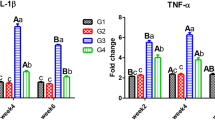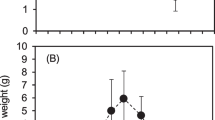Abstract
The endosymbiosis between Paramecium bursaria and Chlorella spp. is mutualistic. Symbiotic algae localize beneath the host Paramecium cell cortex compete for their attachment sites with preexisting organelle trichocysts. To examine the relationship between P. bursaria trichocysts and their symbiotic algae, algae-bearing or alga-free P. bursaria were starved for several days and the changes in the number of Chlorella sp. and presence or absence of trichocysts were evaluated. We conducted an indirect immunofluorescence microscopy with an anti-trichocyst monoclonal antibody against P. bursaria cells. Indirect immunofluorescence microscopy demonstrated that under starvation and darkness conditions, the immunofluorescence of trichocysts in alga-free P. bursaria decreased much faster than that in the normal algae-bearing P. bursaria. In the latter case, our observations proposed the possibility that the nutrition obtained from symbiotic algal digestion may promote trichocysts synthesis. This algal digestion mechanism may permit host P. bursaria cells to survive for a longer time under starvation condition. To the best of our knowledge, this may be a new benefit that host P. bursaria gain from harboring symbiotic algae.





Similar content being viewed by others
References
Goetsch W (1924) Die symbiose der süsswasser-hydroiden und ihre künstliche beeinflussung. Z Morp u Okol Tiere 1:660–751
Lee JJ, Soldo AT, Reisser W, Lee MJ, Jeon KW, Görtz HD (1985) The extent of algal and bacterial Endosymbioses in Protozoa. J Protozool 32:391–403
Van Tright H (1919) A contribution to the physiology of the freshwater sponges (Spongillidae). Tijdschr Ned Dierkd 2:1–20
Harumoto T, Miyake A (1991) Defensive function of trichocysts in Paramecium. J Exp Zool 260:84–92
Brown JA, Nielsen PJ (1974) Transfer of photosynthetically produced carbohydrate from endosymbiotic Chlorellae to Paramecium bursaria. J Protozool 21:569–570
Hohman TC, McNeil PL, Muscatine L (1982) Phagosome–lysosome fusion inhibited by algal symbionts of Hydra viridis. J Cell Biol 94:56–63
Muscatine L, Karakashian SJ, Karakashian MW (1967) Soluble extracellular products of algae symbiotic with a ciliate, a sponge and a mutant hydra. Comp Biochem Physiol 20:1–12
Albers D, Reisser W, Wiessner W (1982) Studies of the nitrogen supply of endosymbiotic chlorellae in green Paramecium bursaria. Plant Sci Lett 25:85–90
Albers D, Wiessner W (1985) Nitrogen nutrition of endosymbiotic Chlorella spec. Endocytobio Cell Res 2:55–64
Reisser W (1976) The metabolic interactions between Paramecium bursaria Ehrbg. and Chlorella spec. in the Paramecium bursaria−symbiosis. I. The nitrogen and the carbon metabolism. Arc Microbiol 107:357–360
Reisser W (1980) The metabolic interactions between Paramecium bursaria Ehrbg. and Chlorella spec. in the Paramecium bursaria-symbiosis. III. The influence of different CO2-concentrations and of glucose on the photosynthetic and respiratory capacity of the symbiotic unit. Arc Microbiol 125:291–293
Kodama Y, Fujishima M (2005) Symbiotic Chlorella sp. of the ciliate Paramecium bursaria do not prevent acidification and lysosomal fusion of host digestive vacuoles during infection. Protoplasma 225:191–203
Siegel R, Karakashian SJ (1959) Dissociation and restoration of endocellular symbiosis in Paramecium bursaria. Anat Rec 134:639
He M, Wang J, Fan X, Liu X, Shi W, Huang N, Zhao F, Miao M (2019) Genetic basis for the establishment of endosymbiosis in Paramecium. ISME J 13:1360–1369
Gu F, Chen L, Ni B, Zhang X (2002) A comparative study on the electron microscopic enzymo-cytochemistry of Paramecium bursaria from light and dark cultures. Europ J Protistol 38:267–278
Karakashian SJ, Rudzinska MA (1981) Inhibition of lysosomal fusion with symbiont-containing vacuoles in Paramecium bursaria. Exp Cell Res 131:387–393
Kodama Y, Fujishima M (2007) Infectivity of Chlorella species for the ciliate Paramecium bursaria is not based on sugar residues of their cell wall components, but on their ability to localize beneath the host cell membrane after escaping from the host digestive vacuole in the early infection process. Protoplasma 231:55–63
Kodama Y, Fujishima M (2008) Cycloheximide induces synchronous swelling of perialgal vacuoles enclosing symbiotic Chlorella vulgaris and digestion of the algae in the ciliate Paramecium bursaria. Protist 159:483–494
Miyake A, Harumoto T, Salvi B, Rivola V (1989) Defensive function of extrusomes, pigment granules in Blepharisma and trichocysts in Paramecium, against a carnivorous ciliate Dileptus. J Protozool 36:28A
Sugibayashi R, Harumoto T (2000) Defensive function of trichocysts in Paramecium tetraurelia against heterotrich ciliate Climacostomum virens. Europ J Protistol 36:415–422
Sugibayashi R, Harumoto T (1998) Zool Sci 15(Suppl):25
Kodama Y, Fujishima M (2009) Localization of perialgal vacuoles beneath the host cell surface is not a prerequisite phenomenon for protection from the host's lysosomal fusion in the ciliate Paramecium bursaria. Protist 160:319–329
Kodama Y, Fujishima M (2011) Endosymbiosis of Chlorella species to the ciliate Paramecium bursaria alters the distribution of the host's trichocysts beneath the host cell cortex. Protoplasma 248:325–337
Omura G, Suzaki T (2003) Changes in trichocysts during re-infection of white Paramecium bursaria by Chlorella. Jpn J Protozool 36:69–70 (in Japanese)
Kodama Y, Fujishima M (2009) Timing of perialgal vacuole membrane differentiation from digestive vacuole membrane in infection of symbiotic algae Chlorella vulgaris of the ciliate Paramecium bursaria. Protist 160:65–74
Tsukii Y, Harumoto T, Yazaki K (1995) Evidence for a viral macronuclear endosymbiont in Paramecium caudatum. J Euk Microbiol 42:109–115
Dryl S (1959) Antigenic transformation in Paramecium aurelia after homologous antiserum treatment during autogamy and conjugation. J Protozool 6:25
Fujishima M, Nagahara K, Kojima Y (1990) Changes in morphology, buoyant density and protein composition in differentiation from the reproductive short form to the infectious long form of Holospora obtusa, a macronucleus-specific symbiont of the ciliate Paramecium caudatum. Zool Sci 7:849–860
Berger J (1980) Feeding behaviour of Didinium nasutum on Paramecium bursaria with Normal or Apochlorotic Zoochlorellae. J Gen Microbiol 118:397–404
Pollack S (1974) Mutations affecting the trichocysts in Paramecium aurelia. I. Morphology and description of the mutants. J Protozool 21:352–362
Altermatt F, Fronhofer EA, Garnier A et al (2015) Big answers from small worlds: a user's guide for protist microcosms as a model system in ecology and evolution. Methods Ecol Evol 6:218–231
Acknowledgements
We thank Professor Masahiro Fujishima (Yamaguchi University, Japan) for giving us the valuable monoclonal antibody against trichocysts. This work was supported by a Grant-in-Aid for Scientific Research (C) (No. 17 K07513) from the Japan Society for the Promotion of Science (JSPS) and by the Institute for Fermentation (IFO), Osaka, Japan, to Y.K. The authors thank the faculty of Life and Environmental Sciences in Shimane University for financial supports in publishing this report and we would like to thank Editage (www.editage.jp) for English language editing.
Author information
Authors and Affiliations
Contributions
Yuuki Kodama conceived and designed the experiments. Yuuki Kodama and Shoya Miyazaki performed the experiments. Yuuki Kodama wrote the manuscript.
Corresponding author
Ethics declarations
Conflict of interest
The authors declare that they have no conflict of interest.
Additional information
Publisher's Note
Springer Nature remains neutral with regard to jurisdictional claims in published maps and institutional affiliations
Rights and permissions
About this article
Cite this article
Kodama, Y., Miyazaki, S. Autolysis of Chlorella variabilis in Starving Paramecium bursaria Help the Host Cell Survive Against Starvation Stress. Curr Microbiol 78, 558–565 (2021). https://doi.org/10.1007/s00284-020-02304-9
Received:
Accepted:
Published:
Issue Date:
DOI: https://doi.org/10.1007/s00284-020-02304-9




